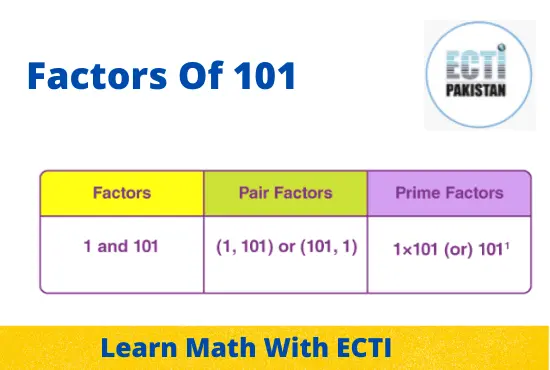Factors of 101 | With Easy Division and Prime Factorization
Contents
Factors of 101
Factors of 101 are the integers or numbers that can completely divide the original number. A pair of factors (i.e., 101 multiplied in pairs) is called a pair factor of 101.
Since 101 is a prime number. Therefore, it has only two following factors.
1, and 101.
Where 101 is the most significant factor.
Suppose you want to know the pair factors of 101. Here, the pair factors are (1,101), and the prime factor is 101.
We can find the factors by using two methods.
- Factorization method.
- Division method.
What are the Factors of 101?
Factors of 101 are numbers that divide 101 precisely without leaving a remainder. There are only two factors.
(1,101)
The factors will divide evenly or equally in 101.
A factor of 101 is an integer multiplied in pairs to create the original number 101. As we know, 101 is a prime number, and it has only two factors, the number itself and 1 (the prime factor).

What are the factors of -101?
We can get -101 by having (-1, 101) and (101, -1) as a pair of factors. Similarly, we can also get -101 by having (1, -101) and (-101, 1) as a pair of factors.
Pair Factors of 101
The pair factor of 101 is the result of multiplying two numbers to get the result of 101. Pair factors of 101 can be positive or negative. Here, are the following positive and negative pair factors of one hundred one:
Positive Pair Factor of 101:
| Positive Factor of 101 | Positive Pair Factor of 101 |
| 1 × 101 | (1, 101) |
Negative Pair Factor of 101:
| Negative Factor of 101 | Negative Pair Factor of 101 |
| -1 × -101 | (-1, -101) |
How to Find Factors of 101?
The factors of 101 can be found by listing all the numbers that divide 101 evenly. Therefore, there are only two such numbers: 1 and 101. Since 101 has two factors, they are 1 and 101.
You can determine this by these two following methods:
- Division method.
- Factorization method.
Check out some other methods.
Factors of 101 by Division Method
You can find the factors of 101 by dividing 101 by different integers. An integer that divides 101 exactly is a factor of 101.
- 101/1 = 101 (Factor =1 and Remainder =0)
- 101/101 = 1(Factor = 101 and Remainder =0)
There is a remainder when we divide 101 by any other number than 1 or 101. Therefore, 101 has two factors: 1 and 101.
Prime Factorization of 101
The number 101 can be written as the product of its prime factors by using prime factorization. Let’s find the prime factors of 101 now.
- Let’s say the pair factor is 101 (1, 101).
- 101 is also a prime number since the number 1 cannot be broken further.
- As a result, write the number as the product of 1 and 101. Hence, 101 = 1 × 101
- Consequently, the prime factorization of 101 equals 1 × 101 or 1011.
As 101 consists of only two factors, it is a prime number. i.e., 1 and 101. Hence, the prime factorization of 101 is just 101(itself).
It is easy to determine the number of factors by adding 1 to the exponent value of 101. It makes 1+1 equal 2.
As a result, the number 101 has two factors. The simplified square root value of 101 is approximately 10.04988 since 101 does not have square factors.
Solved Examples
Example 1: Determine the common factor of 101 and 100.
Solution:
1 and 101 are the factors of one hundred one.
There are 10 following factors of 100.
1, 2, 4, 5, 10, 20, 25, 50, and 100.
Because 101 is a prime number, the only common factor between 101 and 100 is 1.
Example 2: Find the common factors between 101 and 103.
Solution: 101 has two factors:
1, 101.
There are 2 following factors of 103.
1, 103
The common factor of 101 and 103 is 1, as both 101 and 103 are prime numbers.
Example 3: Identify the common factors between 101 and 51.
Solution: 101 has two factors, 1 and 101.
There are 4 following factors 51.
1, 3, 17, and 51.
Therefore, 101 and 51 have a common factor of 1.
How many factors are there in 1001? What is the total number of factors in 1001?
Solution: There are 8 following factors of 1001.
1, 7, 11, 13, 77, 91, 143 and 1001.
As a result, there are eight factors for 1001.
Example 5: How many factors are there in 24?
Solution: There are 8 following factors of 24
1, 2, 3, 4, 6, 8, 12, and 24.
Example 6: How many factors are there in 54 and 38?
Solution: There are 8 factors of 54
1, 2, 3, 6, 9, 18, 27, and 54.
Pair factors of 38 are 1, 2, 19, and 38.
Practice Questions
- How can we find the smallest factor of 101?
- When 50 is multiplied by the greatest factor of 101, what is the result?
- When 5 is a factor of 25, what is the result when 25 is divided by 5?
| Link Related Factors | ||
| Factors of 30 = 1,2,3,5,6,10,15 and 30. | Pair factors of 24 = 1, 2, 3, 4, 6, 8, 12 and 24. | Prime factorization of 34 = 1,2, 17, and 34. |
| Factors of 36 = 1,2,3,4,6,9,12,18, and 36. | Pair Factors of 38= 1, 2, 19, 38. | Factors of 42 = 1, 2, 3, 6, 7, 14, 21, and 42. |
| Factors of 45 = 1, 3, 5, 9, 15, and 45. | Factors of 48 = 1, 2, 3, 4, 6, 8, 12, 16, 24, and 48. | Factors of 49 = 1, 7, 49. |
| Factors of 50 = 1, 2, 5, 10, 25, 50. | The Factors of 54 = 1, 2, 3, 6, 9, 18, 27 and 54. | Factors of 56 = 1, 2, 4, 7, 8, 14, 28 and 56. |
FAQ’S
How many factors does 101 have?
There are 2 following factors of 101.
1 and 101.
As 101 is a prime number.
What is the prime factorization of 101?
1 × 101 or 1011 is the prime factorization of 101.
Write down the positive and negative pair factors of 101.
(1, 101) and (-1, -101) are the positive and negative pair factors of 101, respectively.
Is 2 a factor of 101?
2 cannot be a factor of 101 because the remainder is 1.
Is 101 a factor of 101?
101 is indeed a factor of 101. The remainder is 0 when 101 is divided by
y 101.
